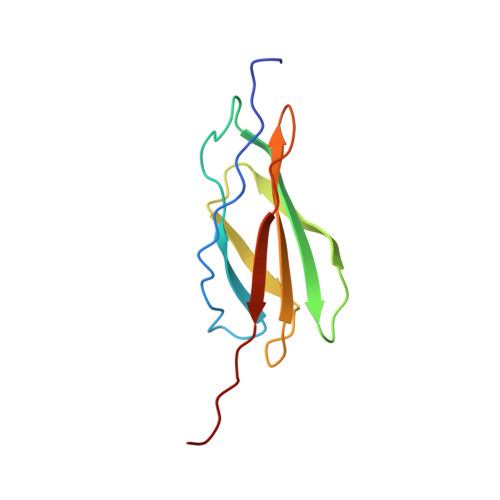The N Terminus of the Prion Protein Mediates Functional Interactions with the Neuronal Cell Adhesion Molecule (NCAM) Fibronectin Domain.
Slapsak, U., Salzano, G., Amin, L., Abskharon, R.N., Ilc, G., Zupancic, B., Biljan, I., Plavec, J., Giachin, G., Legname, G.(2016) J Biological Chem 291: 21857-21868
- PubMed: 27535221
- DOI: https://doi.org/10.1074/jbc.M116.743435
- Primary Citation of Related Structures:
5LKN - PubMed Abstract:
The cellular form of the prion protein (PrP C ) is a highly conserved glycoprotein mostly expressed in the central and peripheral nervous systems by different cell types in mammals. A misfolded, pathogenic isoform, denoted as prion, is related to a class of neurodegenerative diseases known as transmissible spongiform encephalopathy. PrP C function has not been unequivocally clarified, and it is rather defined as a pleiotropic protein likely acting as a dynamic cell surface scaffolding protein for the assembly of different signaling modules. Among the variety of PrP C protein interactors, the neuronal cell adhesion molecule (NCAM) has been studied in vivo, but the structural basis of this functional interaction is still a matter of debate. Here we focused on the structural determinants responsible for human PrP C (HuPrP) and NCAM interaction using stimulated emission depletion (STED) nanoscopy, SPR, and NMR spectroscopy approaches. PrP C co-localizes with NCAM in mouse hippocampal neurons, and this interaction is mainly mediated by the intrinsically disordered PrP C N-terminal tail, which binds with high affinity to the NCAM fibronectin type-3 domain. NMR structural investigations revealed surface-interacting epitopes governing the interaction between HuPrP N terminus and the second module of the NCAM fibronectin type-3 domain. Our data provided molecular details about the interaction between HuPrP and the NCAM fibronectin domain, and revealed a new role of PrP C N terminus as a dynamic and functional element responsible for protein-protein interaction.
- From the Slovenian NMR Centre, National Institute of Chemistry, Hajdrihova 19, SI-1000 Ljubljana, Slovenia.
Organizational Affiliation:
















